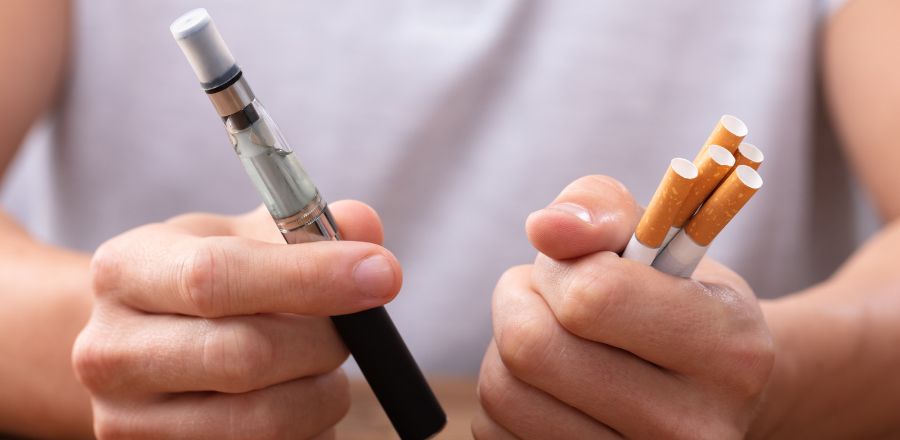AMA on vaping and nicotine harm and addiction
Professor Steve Robson spoke to Radio 2CC, Saturday 21 January 2022 Subject: Vaping and nicotine harm and addiction. AMA Submission to TGA

HOST: Time now to talk about vaping. It does seem to be everywhere, but what do we know about it? Professor Steve Robson is the national AMA President and joins me now. Please explain to me how vaping differs to smoking cigarettes the old fashioned way.
STEVE ROBSON: Well vaping is a relatively new thing - we all are familiar with cigarettes, where you process tobacco, wrap it up in paper and set fire to it. E-cigarettes are different. They're an electronic mechanism that have a little heater in them and you put a capsule of fluid in. That's heated up and turns into a steam that you're able to inhale through the device. So they're called e-cigarettes, and the term that is used for using them and heating them up, inhaling the vapour from them, is called vaping. So they're becoming increasingly widely used in Australia and globally.
TATJANA CLANCY: The AMA has made a submission saying that we're essentially losing that public health battle on vaping. So in terms of the dangers, is that something that the jury is still out on? I mean, I know as an ex-smoker, half the chemicals in the cigarette were just to keep the thing alight. And if that's now out of the picture, how is vaping still dangerous?
STEVE ROBSON: So, tobacco use has a long history. And we know - we're very aware of the enormous health risks of smoking tobacco. And huge public health campaigns around the country have reduced the amount of smoking substantially. And ever since the '70s, the amount of tobacco smoking that went on has fallen. But what has happened in the last few years is that e-cigarettes were initially thought potentially to be another way of helping tobacco smokers give up. Substituting cigarettes with an e-cigarette, that it might be possible to have fewer harms. Now, the jury's a little bit out on that. Nicotine-containing vapes, you may have some role in smoking cessation, but there are lots of other things. There are patches and sprays and all sorts of things that you can work with your doctor to do.
What has grown out of the e-cigarette nicotine phenomenon is what are called recreational vapes. So they're vapes that are not meant to be part of a smoking cessation program. They're vapes that people just use recreationally. And I think there are particular concerns. We know that some of them, even though they've claimed not to have nicotine, actually contain nicotine. And the process of burning them, the chemicals in them can be quite poisonous as well. They're different to those that you get in tobacco smoke, but still important. And because it's relatively new, it's taken us a while to develop a picture of the harms, but we're now seeing acute lung problems. We're seeing everything from tooth decay to addictive problems. And one of the things that, when you speak to school principals, is that they seem to really hook younger Australians. And we're hearing stories of younger Australians who just can't wait through a class. They've got to disappear in the middle of class and have a vape even though they're banned in the school. So we see a big problem, and the massive issue we're concerned about is that they're hooking a new generation, and could well be a gateway to taking up smoking again. So lots of issues that the AMA is concerned about from a public health perspective, Tatjana.
TATJANA CLANCY: So in terms of the nicotine intake, I understand that you are actually consuming a lot more than if you were just to have a single cigarette in one sitting, is that right?
STEVE ROBSON: You're absolutely correct. The way that the nicotine is apportioned in a vape can be a little difficult to control. And there's certainly issues with the quantity in them. And sometimes we're seeing, even though people aren't using as many, because there's such a huge amount of nicotine in one of the vapes, you can really have massive amounts of nicotine. And as we know, that's very addictive. So it's a way of addicting people to something other than cigarettes. But the nicotine is the common thing between the tobacco, cigarette and the e-cigarette.
TATJANA CLANCY: And I guess as opposed to conventional cigarette packets where you've got the milligram amount written on the side, I mean, how do you sort of legislate people understanding how much they're actually consuming in one hit?
STEVE ROBSON: It's very difficult at the moment. The nicotine-containing vapes are to be on a prescription from a doctor. They're to be dispensed, and there are controls on importation. But like all imported things, there has to be quality control and only parts that can be sampled. So we certainly hear stories of variability between what is reported, and sometimes enormous amounts of nicotine. And in fact the TGA, the Therapeutic Goods Administration, is showing now that the overall amount of nicotine consumed by Australians is going up again for the first time since the 1970s, after we've had a lot of success in reducing tobacco cigarette smoking, we're now seeing nicotine swing right back to levels we haven't seen for three or four decades.
TATJANA CLANCY: You talked about this earlier, but you know, you've got increasingly young people becoming quite hooked. And of course, if you're consuming that much nicotine, it's going to happen a lot faster for you. But what about that access? You talk about needing a prescription, but obviously, if 13-year-olds are still walking around with vapes, how are they getting hold of them?
STEVE ROBSON: Because the so-called recreational vapes allegedly don't have nicotine in them - although we know that a lot of them do - so adults can get vapes, e-cigarettes and other vaping products, but it's illegal in the states and territories around Australia to supply anything to do with vaping to an Australian under the age of 18. But you just have to look at any school, schoolyards, streets around schools, cinemas and things to see young Australians are clearly getting access to vapes. And they're marketed directly at young Australians. They often have flavours like bubble-gum, they've got exciting unicorns and all of these images on the vape packets. There's a lot of online access and black-market access to kids. And we're very, very concerned that we have a generation of Australians getting access again to something addictive that can potentially affect their health. And it's a real concern, and it's a concern to many parents.
TATJANA CLANCY: So what are your recommendations then? Because I guess, you know, you said there was a lot of success with lowering smoking rates traditionally where we have the plain packaging. It's like Fort Knox behind a counter to get them out. And they're incredibly expensive as well. So do any of those measures apply here?
STEVE ROBSON: I think a lot of the measures that were very successful in getting Australians off these harmful tobacco cigarettes could be applied to vapes. Now, the first thing if you see sweet smelling, bubble-gum flavoured attractively, highly coloured packaging on things, they're meant to appeal to kids. So some of the things that apply to cigarettes, having health warnings, plain packaging and making sure that those attractive flavours are gone, and having bland flavours would go a long way to reducing that appeal that young Australians find in vaping. And a lot of those things could be legislated. But if they're legislated, we need the state and territory governments to enforce it. And we know at the moment that there's very lax enforcement. The AMA gave its Dirty Ashtray Award to the Queensland Government last year because of the total laxity in enforcing laws around vaping for young Australians.
TATJANA CLANCY: Are they generating revenue? Is that what's happening?
STEVE ROBSON: Well, it's a good point. We don't know quite what's going on with the black market in these products. We know that it costs. It costs young Australians money, their hard-earned money spent on these addictive things, but we know that when young Australians get hooked on something like this, it's bad for them, it is bad for society. And if we can just, at the very least, have state and territory governments actually enforce the laws that are in place, it could be a big step forward.
TATJANA CLANCY: Yeah, well hopefully they will, after this submission, or at least hopefully it's the step one. Do you think we also need one of those really scary ad campaigns like we did with AIDS in the 80s, and the Grim Reaper, and all that sort of stuff?
STEVE ROBSON: I think scary ad campaigns don't actually work. And we know from early on that sometimes they turn into a joke. They turn people off the advertising and not necessarily the product. So we need to be careful. I think education is important, and I think parents have a big role to play. And we know that a lot of parents will do the recreational vaping; if we can get the message through to them; look, what you're doing is not necessarily healthy. And certainly do we really want young Australians taking up another addictive, potentially harmful activity like vaping? So I think scary ads don't really work that well. But education, working with people, championing healthy practices are probably more likely to work. But in the very first instance, just enforcing the laws we have would be a good first step.



